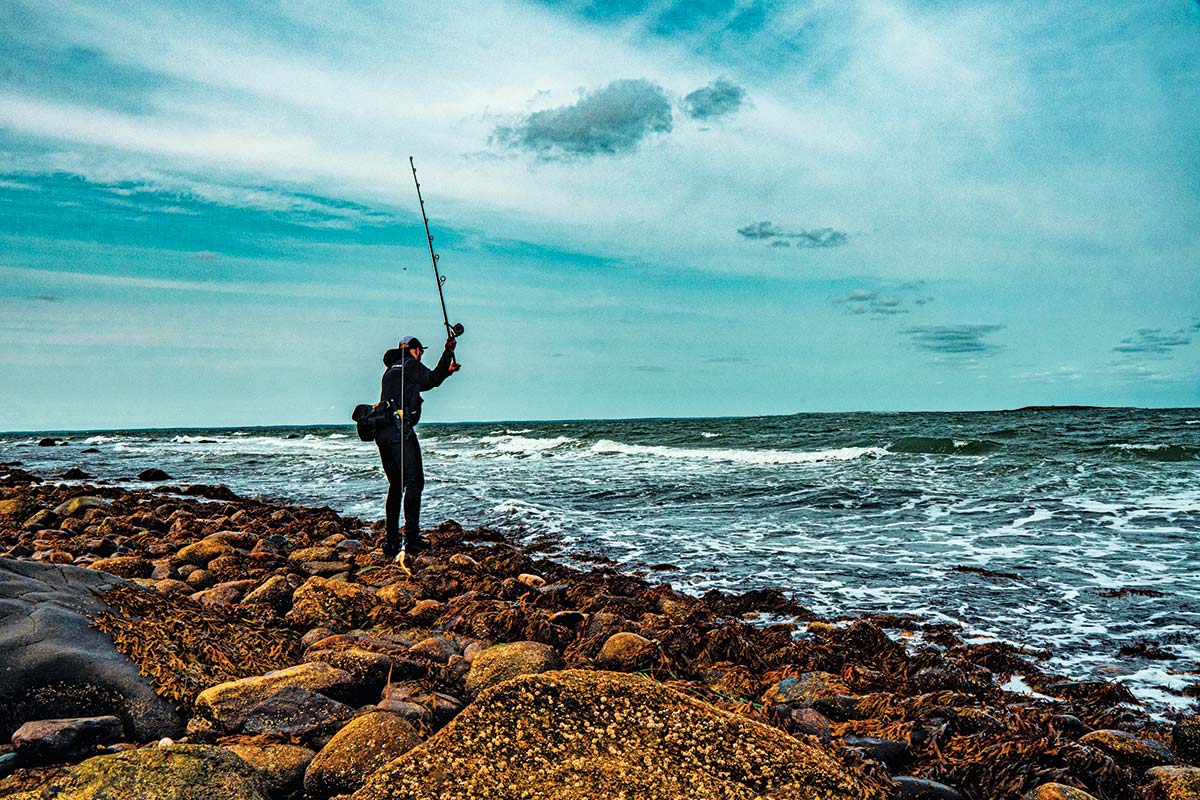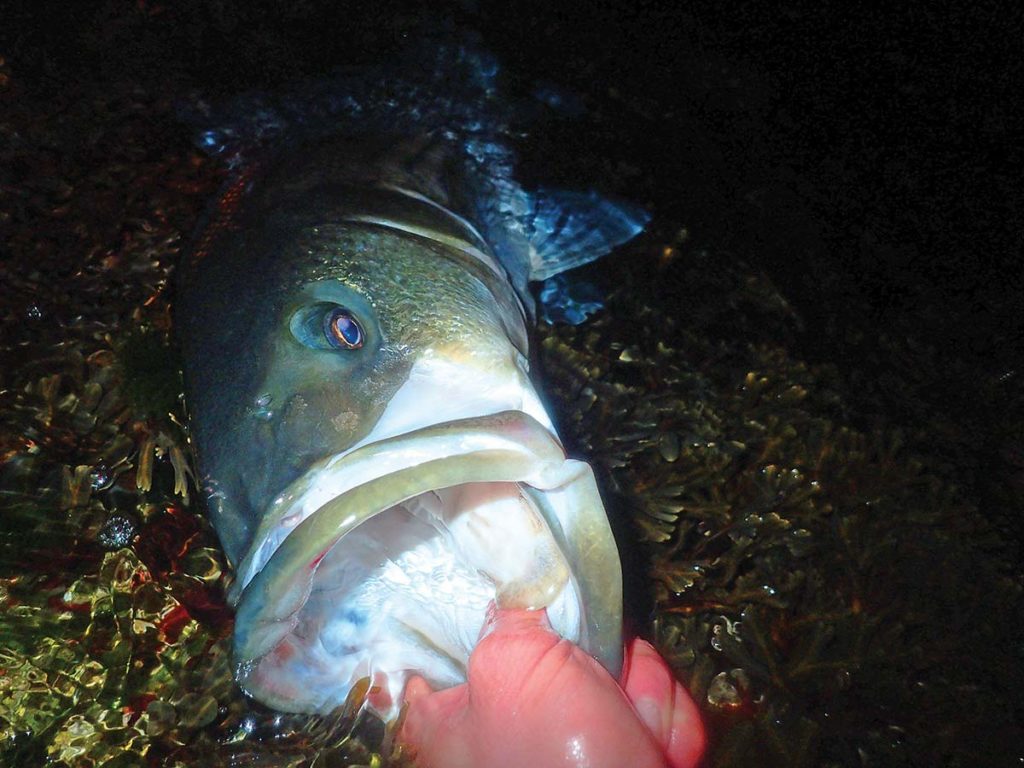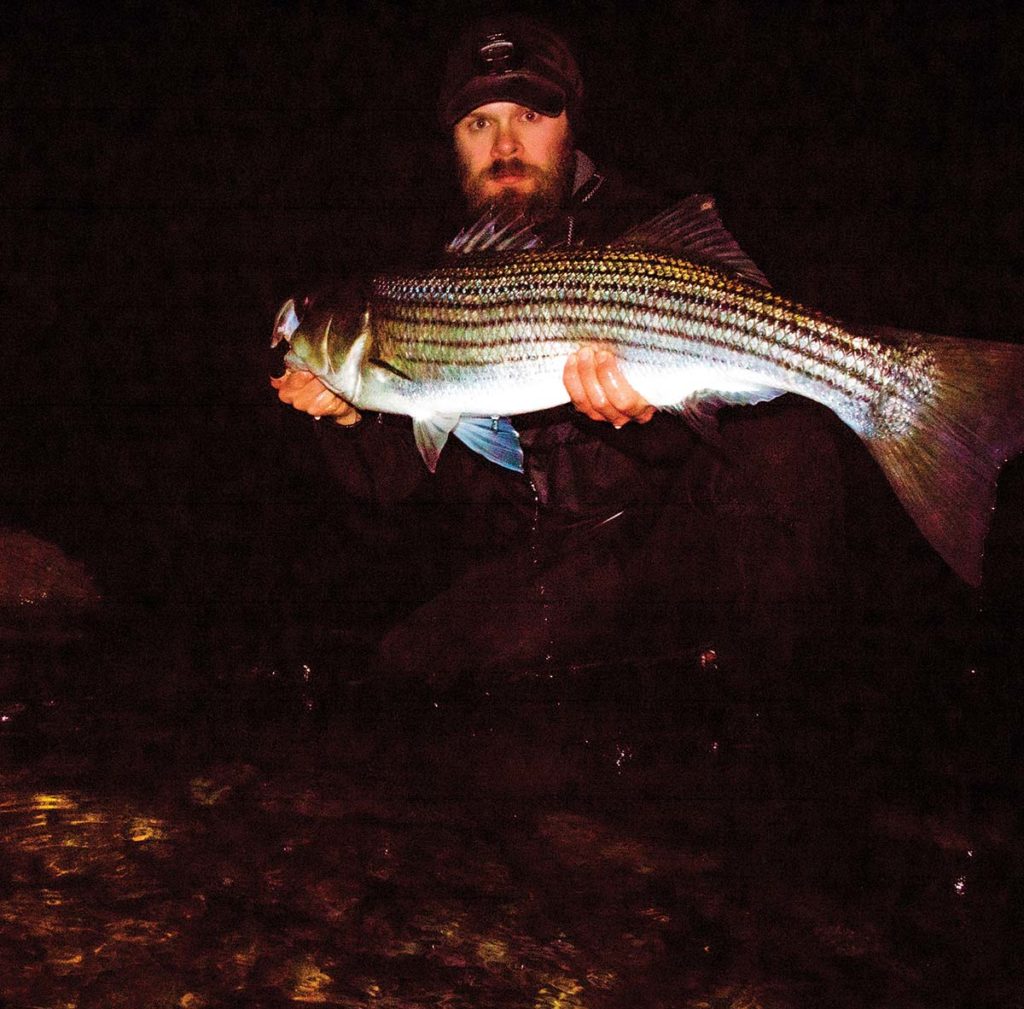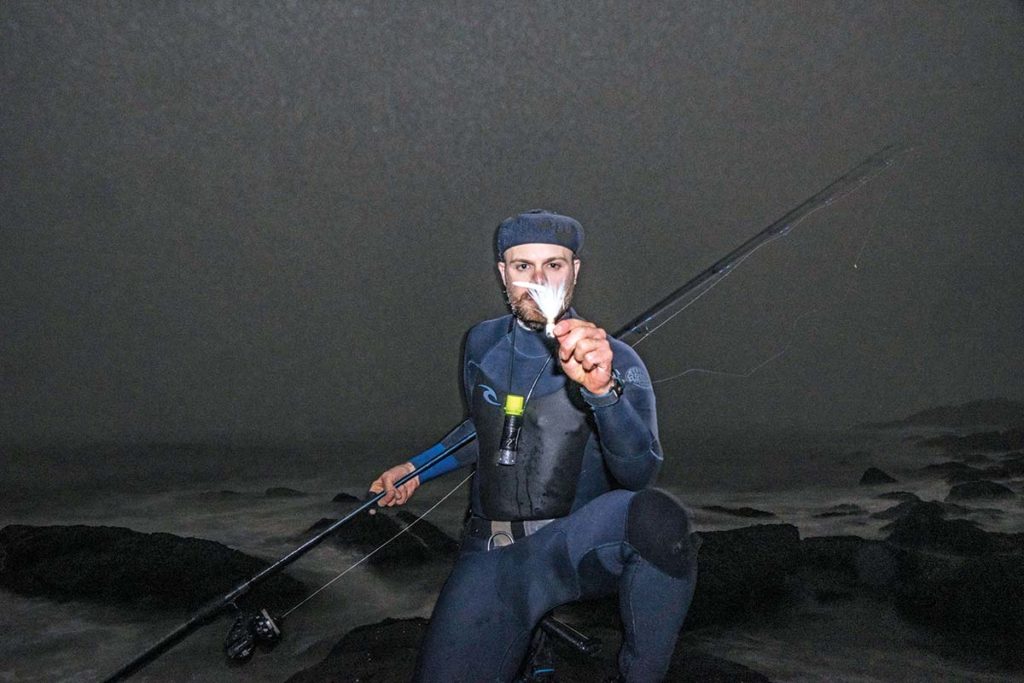
Trimming some hair can affect the casting distance, sink rate, swing rate and profile of your bucktail.
All day long, I couldn’t focus. In my head I was living out what I hoped would be that night’s incredible fishing. The wind had been out of the northeast all day, and the buoys had it blowing steady at about 25-knots, gusting to the mid-30s. It was late fall, and the tides were perfect for a particular spot I fish during these latter stages of the season. Further, I had heard recently that there were some good fish that moved through the Cape Cod Canal, which often means that a body of fish has pushed south. It was one of those scenarios you just know is going to work out. I try hard to never make any proclamations ahead of time, lest I jinx the bite, but this was as good of a sure bet as I could imagine for this time of year and this particular spot. I was giddy as a kid on Christmas morning when I left the house headed for the coast.
As soon as I arrived, I opened the car door and had it ripped from my hand, banging hard against the hinges. I knew I was in trouble. I didn’t need to check the buoys again to know that the wind had intensified to a full-blown gale. Standing there, being pelted by needle-sharp raindrops, I watched the trees bend and sway like they were mere blades of grass. The howl was deafening, and hundreds of yards from the shore I could hear the roar of the surf. In a couple moments, I was already soaked, so I dove back into the car and yanked the door shut. I pulled up the NOAA website on my crummy cell phone, and as I had suspected, somehow the weather predictions from earlier in the day had completely botched the strength of the winds, which had intensified through the evening and into the night. Now, the wind was blowing a solid 40 to 48 knots – almost double what they initially had predicted that morning. I found out afterwards there were gusts approaching 70 knots!
I’m not afraid of fishing conditions like this, but you have to be prepared. Tonight, I was not. I had packed a plug bag full of bottle plugs, darters, and needles that work well in winds up to about 30 knots. Once the wind exceeds that mark, casting distance and the ability to keep tension in the line become problems at this spot. Of course, I had packed some bucktails but they were all relatively small in the ¾- to 1.5- ounce range. This works well at this spot on most typical nights, as there’s a lot of current but not a lot of water depth. On a normal night, it’s a tight-rope walk between snagging bottom, reaching the best strike zones, and not having the bucktail sweep away too quickly. But tonight, I knew it would be all about casting distance. The ¾-ounce would be worthless, and I suspected the 1-ounce would be as well. I crawled over the seat into the back of my car as it rocked in the wind, and searched through my backup bin. I found one more brand-new in the package Chucks Bucks 1.5-ounce bucktail, but not a single one larger. Then, to my horror, I realized I only had- literally- two 50s Uncle Josh’s pork rinds left in my little container. I was really in trouble!

I had driven a long way, so I decided to take a shot at it anyways. I took a moment to calm myself and focus, suited up in my wetsuit, and then after a relatively short walk, I was standing at the edge of a raging sea. The rip was cutting through the waves somewhat, and luckily the waves were mostly wind driven and not associated with a storm swell. They were small enough so I could wade out into the water just a few yards and stand on a small boulder. First cast with one of the 1.5-ounce bucktails confirmed my suspicions – it cast just barely far enough to reach the productive water, but was then swept away too quickly. I needed another 20 yards or more of casting distance so I could snub my cast and get tight to the bucktail fast enough to let it sink for a moment before it swung out of the most productive portion of the rip. I broke my back casting over and over as hard as I could for 15-minutes, trying to force the bucktail to work. I even took off the trailer, and this still didn’t help enough, and my confidence in the “nude” bucktail was low – probably foolishly, but at the time, I was too focused on trying not to get washed into the angry maw of the ocean to stop and think logically about the mind of the striper and how it “sees” bucktails.
Finally, I got a slight lull in the wind, which coincided perfectly with a good cast. Two cranks of the handle of my reel and I was instantaneously tight to a fish. It was a decent 20-pound class fish, and it fought relentlessly – helped by the waves, current, and super-oxygenated water. I was psyched landing that fish, and felt a surge of pride that I was sticking it out under such severe conditions! No photos on this night – it was far too crazy- but I can remember exactly the feelings of letting that fish slide out of my arms and into the foamy wash. It was a great feeling! The euphoria evaporated quickly once I released the fish and started casting again, as I could tell that on 49 out of 50 casts I wasn’t reaching the strike zone now that the tide had dropped a bit. Frustrated, I decided I had to try something, as I was already getting tired, and the opportunity afforded by this storm was slipping away. So, I simply started hacking away at the hair on my bucktail.
It was ugly, but when I got done I had removed about half the hair from the bucktail. It looked awful, and I figured I had simply ruined a high-quality bucktail, and my only backup for the night, lest I lose it. First cast however, the bucktail easily exceeded any cast I had made previously, even accounting for lulls in the wind. And, on that very first cast, I hooked up with another low-20-pound-class striper. That night, I tallied up eight or nine fish between 18 and 25 pounds, and lost one fish that hit so hard and aggressively, it dragged me off my rock and threw me face first into a breaking wave. Trimming the bucktail, as small a difference as it may seem now, was the key to my success.
What’s The Hair For?
There are a lot of lessons and tips that can be gleaned from this story; for example, how to be resourceful, or tenacious, or how you should always be prepared for the worst (and when you’re not, the worst will happen). However, one important and simple lesson is the fact that the details can really matter. In this case, a moderate change in bucktail hair density made all the difference in the world. And while I do believe more hair is generally better when it comes to bucktails, presenting your jig to the fish where they are feeding takes precedent over any and all other variables. Presentation, as I often say, is everything.
The hair on the bucktails serves several important purposes. However, I’ll boil it down to what I see as the two most important: the hair fills out the profile of the lure, and modulates the sink rate. A bulky bucktail with a lot of hair, or even hackle feathers, can mimic larger, full-bodied prey. This is advantageous when trying to lure stripers that may be feeding on big baitfish like tautog, pollock, sea bass, and other larger prey items. It’s also just generally more enticing for large stripers who want big calorie pay offs for their hunting efforts.

Bulky bucktails with dense bodies also sink much more slowly than those with sparse hair. This is particularly important for the surf fisherman who is trying to “swim” their bucktail in the surf, versus swinging it in an inlet. The bulk and buoyancy of the bucktail allows a slower reel retrieve, which is typically more conducive to drawing strikes from stripers. However, in inlets, hair bulk can be used to subtly change drift speeds and depths, and the hard-core “bucktailer” will not only have different weights of bucktails, but different densities as well. On a typical day-to-day basis, I want bucktails with a bulky body. I find that it allows me to use a heavier head, which casts further while at the same time allowing me to reel more slowly, and present a larger total profile to the fish.
However, changing the hair density has a huge influence on how far you can cast. A bulky bucktail with lots of hair and feathers requires a much larger head, and the entire body of the bucktail then is large and does not cut through the wind. A small bucktail, with less hair, will slice through the wind with far more ease than a bulky one with a larger head. For this reason alone, thinner bucktails are absolute essentials in storm conditions like I detailed above. This is particularly true if you’re trying to also mimic smaller baitfish, like the “white bait,” spearing, or sand eels that are often found in the fall surf. For example, if I think the fish are on sand eels, and am trying to reach a distant sand bar, I’ll reach for a smaller, thinner bucktail versus a larger, heavier bucktail every time.
Making The Cut
There are several tips I can give you when it comes to trimming your bucktails, either when you’re on the beach or prior to a trip. First, I like to always start with a bulky bucktail. I’ll buy bucktails with high-quality hair that is dense, because you can always remove hair, but it’s far, far more difficult to add it back again. Also, once you get used to a specific brand and head design, you can buy identical bucktails and trim a series of them, from just a tiny bit, to very sparse, and have a set of bucktails with the same size head that will perform differently in variations of wind and current. This is particularly useful when you have a lot of experience at a specific spot, and small differences can result in large changes in hook-up ratio, or if you’re trying to mimic small prey but need to casting distance or change the sink rate or drift speed.
Next, when trimming, try to keep the bucktail consistent all the way around. That is, don’t take out big chunks from one side or the other, top or bottom. While I have found that it actually doesn’t make as much difference as you might think, it does keep the appearance of the jig more natural. I have some very ugly bucktails where huge portions are missing – these bucktails were altered quickly on a jetty or on a beach with pliers. While these bucktails still produce, I often pass over them for jigs with a more consistent appearance. I pay particular attention to the bottom of the jig, and keeping the hair there more intact. This is because at the spots I fish, stripers are generally coming at the jig from below, and I believe maintaining hair density there preserves the profile of the bucktail more so then either side, and certainly the top. You should consider where the fish are viewing your jig from when you’re trimming: if the fish are coming from the side, or behind, there is even more reason to keep the trimming consistent.

Finally, it probably goes without saying that “less is more” when it comes to trimming the hair. I like to just start with a little, see how the jig performs, and then do a little more until I get my desired result. “Measure twice, cut once” is a saying often used in carpentry, and while you’re not really measuring anything here, you should be thinking about maintaining shape and profile of the jig prior to just hacking away at it. It can be easy to go too far with one single cut. Go slow, be methodical, and use sharp scissors to do the trimming if you have them. However, I will admit that I’ve also just used pliers to yank out hair in a pinch- when the bite is hot, or you’re standing on a rock in pounding waves, you simply have to do whatever is necessary to make it work.
In closing, there are lots of ways to change the casting distance, sink rate, swing rate and profile of a bucktail jig. Changing head size and trailer size or composition are the two simplest and most common. However, when conditions call for a bucktail and you’re “out in the field” unprepared for a drastic change in conditions or simply forgot more jigs or trailers, trimming the hair can make moderate changes that can be enough to offset casting deficiencies or alter presentation depths. Being resourceful is the name of the game in surf fishing, and I hope this simple tip will save you in a pinch.




